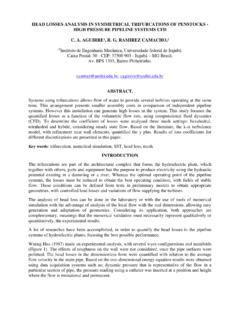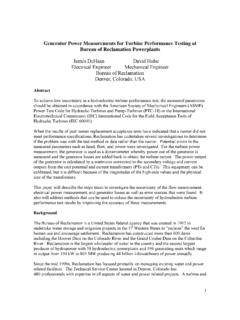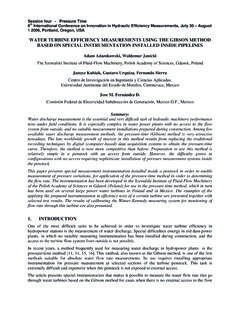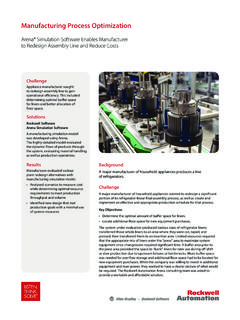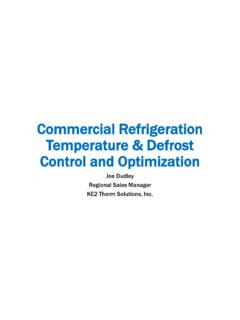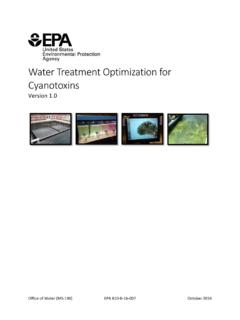Transcription of Optimization of Hydro-Power Plants for Generation
1 - 1 - Optimization of Hydro-Power Plants for Generation Jim Cook Jim Walsh Abstract A decision support system is presented that addresses optimal unit dispatch and load allocation in a multi-unit hydroelectric plant. The concept behind the Optimization approach is explained. Estimates of the improvements this system can provide over existing plant operational methodologies are provided. Actual use of this system has provided gains of over 2% in plant performance. Introduction Process Optimization software can be found in many forms. It can be tightly integrated as a fundamental part of an automated system or exist as an aid to guide personnel in setting system parameters for optimum operation.
2 Software in this latter category is often referred to as decision support. A decision support system is presented here that addresses optimal unit dispatch and load allocation in a multi-unit hydroelectric plant. Initially, the concept behind the Optimization approach is explained, covering its scope and approach. Then a case study examining the benefits that could be obtained over an existing plant's operational methodologies is provided. Finally, a spreadsheet tool for implementing the system is provided. In testing under actual conditions, this system has provided gains of over 2% in plant performance. Optimization in the context of a single plant Optimization covers a broad variety of topics when considering the performance of hydro electric Plants .
3 In run of the river schemes involving two or more Plants cascaded on a river system it is common to consider timing the available energy to meet a peak load as optimizing the river system . Various types of river and plant models that deal with parameters having a system wide scope are necessary for such Optimization . What is often ignored though is the performance Optimization of each plant considered in isolation. This paper deals specifically with such individual plant Optimization issues. Specifically, it addresses the optimal dispatching and loading of units within an individual plant to minimize that plant's discharge for a given load requirement or to maximize that plant's power for a given discharge requirement.
4 It should be mentioned that while this paper deals with performance improvements at the individual plant level, Optimization is also often performed at an individual unit level. For instance, with Kaplan units the blade angle is optimized (on-cam) for a given head and wicket gate opening. The plant level Optimization process introduced here assumes either Francis style units or "on-cam" Kaplan units are being used and focuses on the allocation of load between units to meet a specific plant output requirement. - 2 - Right from startup the operating characteristics ( Generation vs. flow characteristics at given heads) of new units having the same hydraulic design are slightly different.
5 This is due to manufacturing tolerances as well as variations in the inlet and outlet arrangements at the power plant. Normal wear and tear as the units age caused by cavitation and silt erosion as well as wear and seal ring clearance degradation combined with the repair of this damage will tend to increase these operating differences, sometimes dramatically1. Field testing units by simultaneously measuring individual unit power and discharge at a given operating head with modern instrumentation can quantify these differences. The operation of hydroelectric Plants can be improved when these differences are known with sufficient precision. Although it is often ignored, such data is used to optimize the output of many multiple unit hydroelectric Plants in the United States.
6 The Tennessee Valley Authority (TVA), the United States Bureau of Reclamation and the United States Army Corps of Engineers all have invested heavily in Optimization of their hydro Generation assets at the single plant level. TVA considers such Optimization a vital program and monitors all of their Plants in real time to maximize power output while minimizing turbine discharge. This monitoring is performed at both run of the river and storage release Plants . A crude order-of-magnitude calculation based on TVA s experience with real-time Optimization provides a convenient rule of thumb for estimating the production improvements to be expected if this approach is used elsewhere.
7 It turns out that the improvement is roughly equivalent to the variation in performance among units divided by the number of units. If units have been run for several years and have had their turbines repaired, performance differences have been found to range from 1% 2 to 7% 3 4. So in a seven unit plant one could expect improvements of up to about 1%. The Pensacola case study presented later in this paper contains operational data suggesting that this rule might be very conservative. More work is currently being undertaken jointly by the US Army Corps of Engineers and Bonneville power Administration to obtain individual plant characteristics for use in optimally dispatching and allocating load on multiple unit hydroelectric Plants .
8 According to Tom Murphy at BPA5, every 1% of efficiency improvement on the Colorado River in the Pacific Northwest is worth 3 Million dollars annually. A study backed up with actual tests made by Niagara Mohawk at their School Street power Station in the early 1990's also addressed single plant Optimization . The School Street power Station is in Cohoes New York and operates in a run of the river mode. 1 Robert Karlicek, Test Equipment And Results From 25 Hydraulic Turbine Tests using Thermodynamic Method IGHEM- Montreal 1996. 2 ibid. 3 James Walsh, Performance Tests on Pump Turbines at Salina Pump Storage Facility November 1991.
9 4 Levesque, , C. Langvin Field Measurement Results on Replacement Runners at Shawinigan2 and Bersimis 1 Case Study EPRI Hydraulic Turbine Testing Workshop/ Seminar June 1987 York Pennsylvania 5 hydro Optimization AND EFFICIENCY IMPROVEMENTS presented to Environmental Protection Agency May 10 2006. - 3 - This station has 5 Francis style units with a total capacity of 34 MW. The study documented differences in unit operating characteristics that could lead to poor choices when selecting the dispatch and load allocation on various units. The report concluded that overall gains in production of up to % were achievable6. In 2006 School Street Station generated 220,555 MWhrs7.
10 A gain in Generation would yield 9,704 At $50 / Mwhr this would amount to over $485,000 USD annually. Visualizing the system 's operation An important key to solving any problem is to find an efficient way to visualize it. We've attempted to do this in Figure 1 by plotting total plant Generation vs. total plant flow for a database of different unit and associated set point choices in a three unit plant. A unit choice refers to a subset of units selected to operate when there isn't sufficient flow to operate all of the plant's units. An associated set point choice refers to the sequence of discharge settings for the chosen operating units. It's easy to notice that the plot seems to represent well defined characteristic curves.
